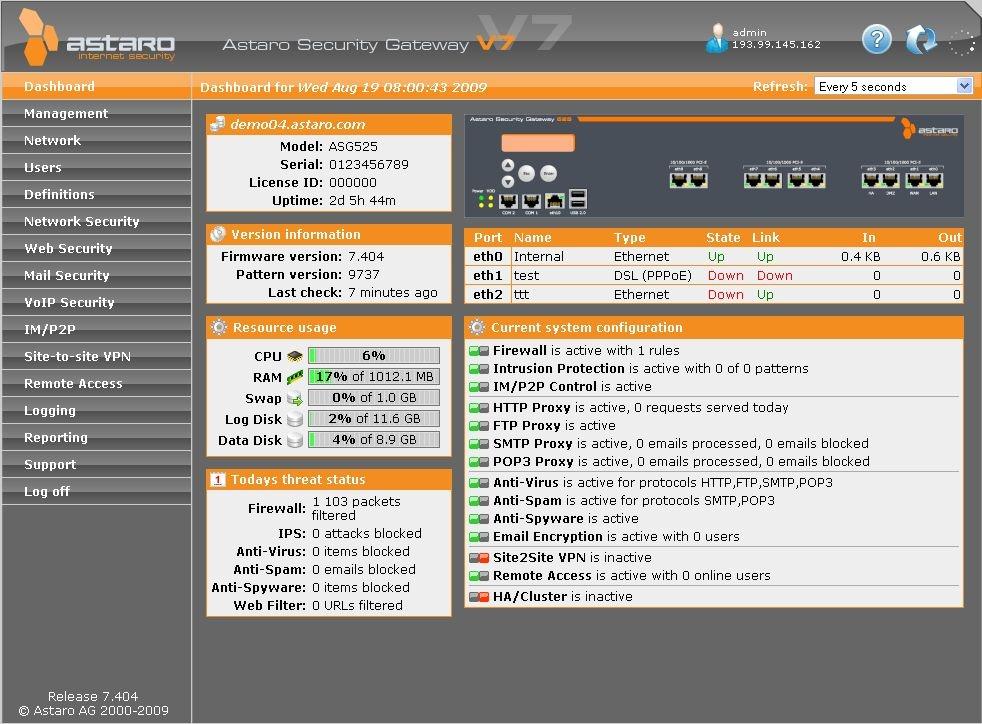Moleskine and evernote. The Sophos UTM Free Home Use firewall contains its own operating system and will overwrite all data on the computer during the installation process. Therefore, a separate, dedicated computer is needed, which will change into a fully functional security appliance. Just right for the spare PC you have sitting in the corner! Sophos UTM (formerly known as Astaro Security Gateway) integrates complete security software within a single appliance. Choose only the protection you need when you need it. And deploy it on the platform that best fits your business: software, hardware or virtual appliance.
Sophos UTM Shell Commands:
Remember:
Direct configuration of Astaro from the shell is unsupported, unless directed to by Astaro Support staff or official documentation.
For paid licenses, modifications done from the shell without direction or sanction may nullify your support agreement.
Run Astaro HTTP proxy database localy
1. ssh to ASG and login with loginuser
2. su – root
3. cc set http sc_local_db [disk][mem][none] (Choose what you prefer)
4. /var/mdw/scripts/httpproxy restart
Websurfing will be extremely slow until the database has downloaded and been put into place. The time is link speed dependent.
View the link speed for the ASG’s interfaces?
‘ifstat’.


Astaro Utm

Silverlit cameras. Bandwidth usage – IFTOP
Astaro also offers the command ‘iftop’ to see the live traffic and traffic statistics.
One can see the traffic live on an interface for Source Host, Destination Host, and Ports.
The peak and accumulative traffic is also displayed.
Run ‘iftop’
Example:
root # iftop -i eth1
Sophos MyUTM Licensing Portal
Host display:————————–General:
n – toggle DNS host resolution——P – pause display
s – toggle show source host———h – toggle this help display
d – toggle show destination host—–b – toggle bar graph display
t – cycle line display mode———–B – cycle bar graph average
————————————— T – toggle cummulative line totals
—————————————- Port display: j/k – scroll display
N – toggle service resolution———f – edit filter code
S – toggle show source port———-l – set screen filter
D – toggle show destination port—–L – lin/log scales
p – toggle port display—————- ! – shell command
q – quit
Sorting:
1/2/3 – sort by 1st/2nd/3rd column
< – sort by source name
> – sort by dest name
o – freeze current order
Concurrent Connections:
sysctl -w net.ipv4.netfilter.ip_conntrack_tcp_timeout_establ ished=86400
number of established connections:
less /proc/net/ip_conntrack | grep ESTA | wc -l
1907
number of all connections:
less /proc/net/ip_conntrack | wc -l
3315
number of connections with status WAIT (close_wait):
less /proc/net/ip_conntrack | grep WAIT | wc –l
39
Saving Snapshots of TOP automatically every half hour
create a cron job with,
top -b -n 1 >>/tmp/top-report.txt
An entry for each CPU core, and possibly another if the CPU(s) has hyperthreading:
cat /proc/cpuinfo
stopped and started again the HTTP proxy:
“/var/mdw/scripts/httpproxy stop” and “/var/mdw/scripts/httpproxy start”
Restarting MiddleWare:
service mdw restart
(from root)
Warning: it doesn’t cause a complete reboot, but it does cause an HA failover, interruption of any up/downloads and VoIP calls, etc.
HD
Find what is taking the space type
df –h
df will only tell you how full the disk is.
du will tell you what files/folders are using the most space
I’d recommend:
cd /var/storage
du -sh *
find the offending directories
What kind of CPU
“cat /proc/cpuinfo”?
Determine if the disk is overloaded
vmstat -d 5
or
vmstat -d | head -2 ; vmstat -d 5 | grep hda
if hda is your hard disk; sda for scsi
That should have similar output.
The ‘5’ is 5 second updates.
You’ll have to look at the differences between the lines to figure out how many IO’s you’re getting in those 5 seconds, and whether you’re saturating the disk or not.
See detailed info about your eth:
# ethtool eth1
OR
-mii-diag eth1
webadmin passwd lost
A user may use the following commands to reset the system passwords:
cc
RAW
system_password_reset
Ctrl c
Upon saving the file and exiting, the admin may immediately navigate to WebAdmin and re-specify all passwords for the system accounts of Astaro Security Linux.
DNS Flush cache option missing in V7
the current workaround is to restart the DNS proxy from the command line as root with the following command:
/var/mdw/scripts/named restart
To change version number
login as loginuser
su –
edit /etc/version
save the file
restart the ASG so the new version is displayed in Webadmin dashboard
Change NIC order
login as loginuser
su –
edit /etc/udev/rules.d/70-persistent-net.rules
save the file
restart the ASG so the new order is loaded.
Locked out – How to regain all logins
1) Shutdown the firewall and connect a screen and a keyboard to the firewall
2) Power on the firewall, wait until the GRUB-loader starts and press ‘ESC’
3) Select ‘Astaro Security Gateway 7.2’ (not previous or rescue!)
4) Press ‘e’ to edit and select the 2nd entry
5) Press ‘e’ once again and enter ‘init=/bin/bash’
6) Press ‘ENTER’ and ‘b’ to boot up
7) Now you are able to change the passwords for ‘loginuser’ and ‘root’
8) After that press CTRL + ALT + DEL to reboot the system and wait until you get the login prompt
Reset to factory settings
Login the command-line as ‘loginuser’, afterwards as ‘root’ and enter following commands to restore to factory settings:
1. cc [Press ENTER]
2. RAW [Press ENTER]
3. system_factory_reset [Press ENTER]

The system will automatically shutdown when it’s finished.
Source: https://community.sophos.com/products/unified-threat-management/f/general-discussion/21326/astaro-useful-shell-commands
Astaro Utm
Related Posts
